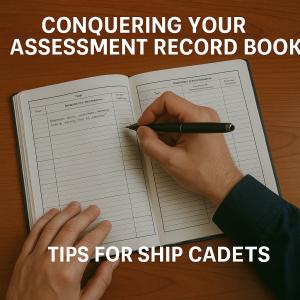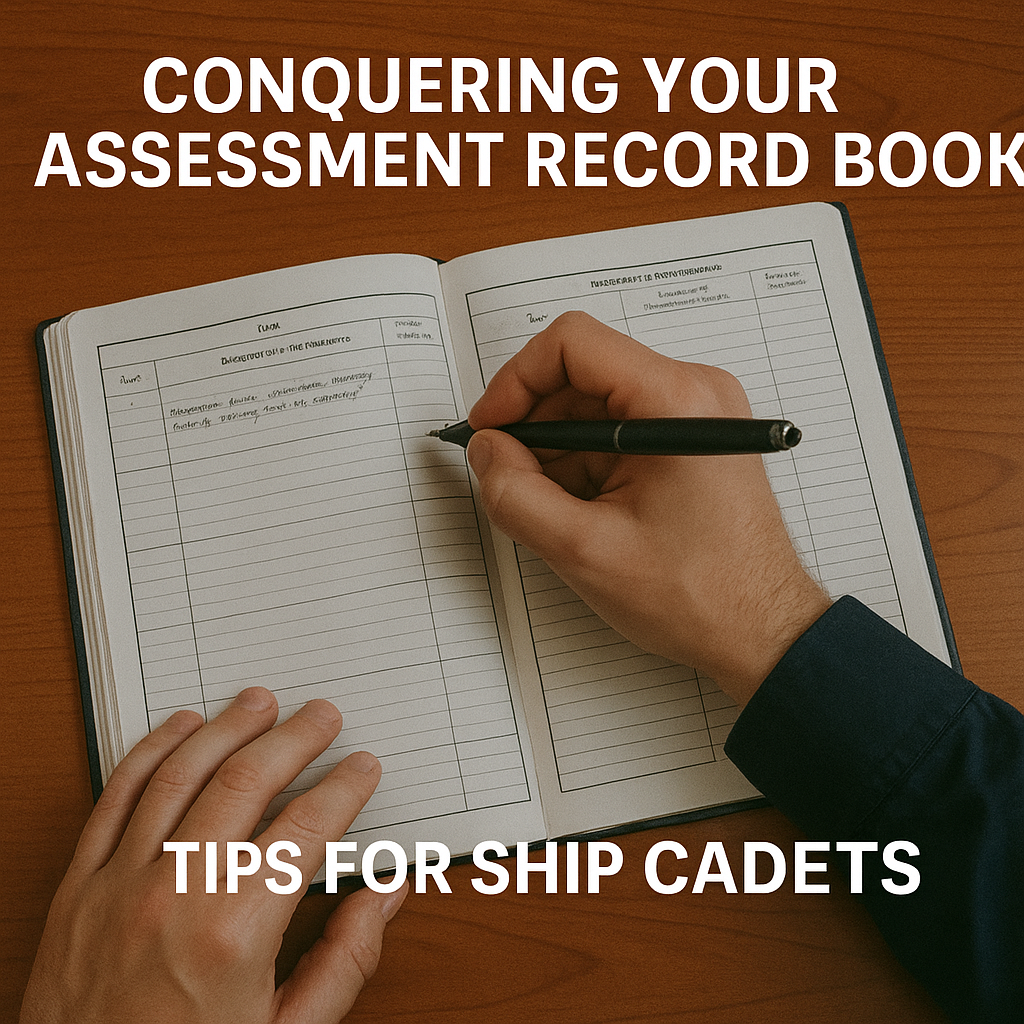 Struggling with your Assessment Record Book (ARB) as a ship cadet? Discover expert tips, real-world examples, and proven strategies to complete your ARB with confidence. Learn how to turn this challenge into a career-boosting opportunity in the maritime industry.”
Struggling with your Assessment Record Book (ARB) as a ship cadet? Discover expert tips, real-world examples, and proven strategies to complete your ARB with confidence. Learn how to turn this challenge into a career-boosting opportunity in the maritime industry.”
Becoming a seafarer is a journey filled with discipline, learning, and resilience. For cadets, one of the most significant milestones is completing the Assessment Record Book (ARB)—sometimes called a Training Record Book (TRB). This document isn’t just a formality. It’s a professional diary, a proof of competence, and in many ways, the passport to becoming a licensed officer.
Yet, for many cadets, the ARB can feel overwhelming. The sheer number of tasks, signatures, and requirements can cause stress. But here’s the truth: mastering your ARB is less about ticking boxes and more about developing habits, skills, and confidence that will serve you throughout your maritime career.
This article is your comprehensive guide to conquering the ARB—from understanding its purpose, to strategies for completing it effectively, to real stories from seafarers who made it through.
Why the Assessment Record Book Matters
What is a Ship Cadet Record Book?
A Ship Cadet Record Book is a structured logbook, which can be physical or increasingly digital, that serves as an official diary and tracking document for a cadet’s time at sea. It is meticulously designed around the standards mandated by international conventions, primarily the STCW (Standards of Training, Certification, and Watchkeeping), and national maritime authorities. Its primary function is to act as legal proof that the cadet has completed the mandatory sea time required for certification. Beyond this, it provides evidence of acquired competence by demonstrating that the cadet has been trained in and has proficiently performed specific practical tasks across various ship departments. The record book also functions as an essential guide for learning, outlining the objectives of the sea phase to steer the cadet’s experience, and as a tool for assessment, allowing ship officers to evaluate performance and formally sign off on completed tasks.
Key Components of a Typical Record Book
A typical Record Book contains several key components, with the exact format often varying by country or sponsoring company. It begins with a section for Personal and Ship Particulars, which includes the cadet’s details, the ship’s name, IMO number, the shipping company, and the dates of embarkation and disembarkation. The most frequently updated section is the Daily Diary or Log, where cadets must provide a detailed account of their daily activities, watchkeeping duties, maintenance tasks, and lessons learned. Another crucial part is the Task Lists and Competency Checklists, which comprise a comprehensive list of duties grouped by deck or engine departments. Each task requires a sign-off from a qualified officer. Dedicated Watchkeeping Records provide a table to log all hours spent on different types of watch. The record book also includes sections for Officer Evaluations, where senior officers provide formal written assessments, and finally, a vital Final Sign-Off and Stamp page that must be validated by the ship’s Master with the ship’s official stamp to make the entire document legally valid.
How to Use It Effectively: Tips for Cadets
To use the record book effectively, cadets should adhere to several important tips. The cornerstone of good practice is to start early and update the diary daily, as memories of specific tasks and lessons fade quickly. Entries must be detailed and professional; rather than writing “did watch,” a cadet should describe specific activities to provide a robust record of their experience. Being proactive is essential; cadets should regularly show their book to supervising officers and actively seek out opportunities to complete required tasks. Seeking feedback during sign-offs demonstrates initiative and a genuine desire to learn. Given its importance, the record book must be kept safe from damage, and cadets are wise to create digital backups of completed pages. Ultimately, the most critical step is to ensure every section is signed and that the Captain’s final signature and official stamp are secured before disembarking the ship.
Where to Get a Record Book
Cadets typically acquire their record book from their Maritime Academy or College, which provides versions pre-approved by the national maritime authority. Alternatively, they can be obtained directly from the National Maritime Administration itself, such as the US Coast Guard or the UK Maritime and Coastguard Agency, which often have specified formats available. Some large Shipping Companies also provide their own customized record books for cadets. It is always imperative to check with the sponsoring academy first to ensure the correct, approved version is used.
The Digital Shift: e-Logbooks
The industry is currently undergoing a digital shift with the adoption of e-Logbooks. These platforms or apps offer significant advantages, including easier updating, better security against loss, the ability to incorporate photos and videos as evidence, and the functionality for remote monitoring by company superintendents and training institutes. However, they also present disadvantages, such as the dependency on reliable internet access at sea—though this is improving—and a potential preference for the traditional paper method among some senior officers. Despite this technological evolution, the core principles of maintaining a detailed, officer-verified log as proof of sea time and competence remain unchanged.
The Common Struggles Cadets Face 😓
Many cadets find the ARB stressful because of:
-
Procrastination: Waiting until the end of contract to fill pages.
-
Officer Availability: Struggling to get signatures when senior staff are busy.
-
Language Barriers: Non-native English cadets sometimes misinterpret tasks.
-
Fear of Mistakes: Worrying that imperfect entries will harm exam chances.
The Nautical Institute and ISWAN (International Seafarers’ Welfare and Assistance Network) note that poorly managed ARBs can even affect mental wellbeing, creating anxiety among cadets.
Strategies to Master Your ARB
Here’s how you can transform the ARB from a burden into a tool for growth:
Start Early and Stay Consistent
Don’t wait for “the right time.” Fill entries as soon as tasks are completed. A study by Warsash Maritime Academy found that cadets who updated ARBs weekly had 40% higher completion rates.
Build Officer Relationships
Politely approach senior officers. Show enthusiasm for learning. When officers see cadets are genuinely engaged, they are more willing to observe and sign tasks.
Understand the Task, Don’t Just Copy
Read each requirement carefully. For example, “Operate emergency steering gear” isn’t just watching—it means understanding the procedure, controls, and reporting lines.
Use Cross-References
If you performed a task during a SOLAS fire drill, note “linked to Regulation III/19 (Emergency Training and Drills)”—this shows examiners your awareness of IMO standards.
Keep it Neat and Professional
Think of your ARB as part of your resume. Avoid scribbles, torn pages, or blank sections. Use clear handwriting or academy-approved digital entries.
Real Stories: Cadets Who Conquered Their ARB
Story 1: The Reluctant Signatures
Ali, a deck cadet from Pakistan, sailed with a very busy master who rarely had time for paperwork. Instead of waiting, Ali politely offered to prepare entries in advance. When the master had 15 free minutes, Ali would present neatly written tasks ready for signature. His proactive approach paid off—he completed his ARB ahead of schedule.
Story 2: The Engine Room Language Barrier
María, an engine cadet from Peru, initially struggled with English technical terms. She started keeping a mini-glossary of machinery parts in Spanish–English. When she presented her ARB, she included this as an appendix. Examiners praised her initiative, and it also helped her pass her oral exam.
Case Study: Linking ARB with Maritime Safety
The MAIB (UK Marine Accident Investigation Branch) has investigated several accidents involving cadets. A recurring theme: tasks like enclosed space entry or mooring line handling were either improperly supervised or not logged.
In one 2020 case, a cadet was injured during mooring because he had never been assessed in line handling. His ARB showed gaps in that section. This case reinforced why regulators like Paris MoU and Tokyo MoU port state controls emphasize cadet supervision and training records.
The Bigger Picture: Why ARBs Build Safer Shipping
Globally, over 80% of maritime accidents involve human error (ICS, 2023). Training tools like the ARB directly address this by:
-
Ensuring cadets practice under supervision.
-
Creating a culture of safety and accountability.
-
Standardizing training across nations.
The World Maritime University (WMU) stresses that ARBs are not only for cadets but also for shipowners and regulators, since they prove a structured investment in safety culture.
FAQ: Assessment Record Book Explained
1. What happens if I lose my ARB?
Most administrations allow replacements, but you may need affidavits and proof of sea service. Always keep scanned copies.
2. Can officers refuse to sign tasks?
Yes—if they believe you haven’t demonstrated competence. See it as feedback, not failure. Ask for guidance, then try again.
3. Is the ARB different for deck and engine cadets?
Yes. Deck ARBs focus on navigation, cargo, and seamanship; engine ARBs on machinery operation, maintenance, and safety systems.
4. How is the ARB assessed?
Maritime academies and examiners review it before your Certificate of Competency (CoC) oral exam. Incomplete ARBs can delay certification.
5. Can I complete tasks outside my ship type?
Yes, but some tasks (e.g., tanker cargo operations) may require additional simulator training or sea service on a specific vessel type.
6. Do digital ARBs exist?
Yes. Several academies now use electronic TRBs (eTRBs), allowing online officer signatures and better monitoring by training institutions.
Conclusion: Your ARB Is Your Story 🌊
Your Assessment Record Book is more than paperwork—it is the story of your growth as a seafarer. Each signed page proves not only that you can perform a task, but also that you learned responsibility, teamwork, and professionalism.
Cadets who treat the ARB seriously gain more than a certificate—they earn respect, confidence, and smoother career progression.
So, don’t just “finish” your ARB. Own it. Learn from it. Conquer it. One day, when you sign the ARB of your own cadet as a chief officer or chief engineer, you’ll remember how this journey shaped you. ⚓
References
-
International Maritime Organization (IMO). STCW Convention and Code.
-
International Chamber of Shipping (ICS). (2023). Shipping and Human Element Report.
-
The Nautical Institute. Training Resources.
-
Marine Accident Investigation Branch (MAIB). Safety Bulletins.
-
Warsash Maritime Academy. (2021). Cadet Training Reports.
-
International Seafarers’ Welfare and Assistance Network (ISWAN). Cadet Support.
-
World Maritime University (WMU). (2022). Global Maritime Training Report.
-
Paris MoU. Port State Control Guidelines.


👏